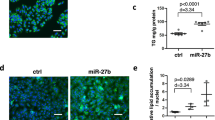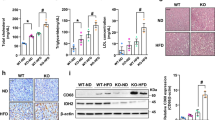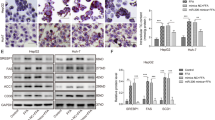Abstract
Background:
Hepatic expression of microRNA-107 is ubiquitously upregulated in various metabolic diseases. In our previous study, we had demonstrated that fatty acid synthase (FASN) is a target of miR-107. miR-107-FASN interaction, by inducing endoplasmic reticulum (ER) stress, promotes lipid accumulation in hepatocytes. Here, we explore the possible mechanism(s) of the miR-107-FASN-ER stress on hepatic lipid metabolism.
Methods:
HepG2 cells were transfected with the scramble or miR-107 and/or its inhibitor. Transcript levels of lipid droplet membrane proteins, apolipoproteins and β-oxidation genes were quantified by quantitative reverse transcription-PCR. Cells were treated with tunicamycin (Tm, 1 h) and 4-PBA (4-phenyl butyric acid, 8 h) or transfected with hydroxyacyl-CoA dehydrogenase/3-ketoacyl-CoA thiolase/enoyl-CoA hydratase, apha subunit (HADHA) short interfering RNA or its overexpression vector. Mice were injected with the scramble or mmu-miR-107 (2.5 mg kg−1 body weight) and random glucose levels were measured and oral glucose tolerance test was performed. Serum levels of cholesterol, triglyceride and serum glutamic oxaloacetic transaminase/serum glutamic-pyruvic transaminase (SGOT/SGPT) were evaluated. Hepatic tissues were collected to estimate levels of miR-107 and mitochondrial β-oxidation genes. Six-micrometer-thick cryosections of hepatic tissues were prepared and stained with Oil Red O for lipid accumulation.
Results:
miR-107 does not alter the expression of lipid metabolism-related transcription factors, lipid droplet components and apolipiprotein B. miR-107 significantly decreased the levels of the mitochondrial β-oxidation enzyme, HADHA in HepG2 cells (P<0.01), which was prevented by the miR-107 inhibitor. Similar decrease was observed with Tm (P<0.001), suggesting that HADHA inhibition is promoted by ER stress induction. Interestingly, miR-107-mediated HADHA suppression was rescued by the ER stress inhibitor, 4-PBA (P<0.01). HADHA overexpression rescued miR-107-induced lipid accumulation (P<0.01). miR-107 injection in mice increased random blood glucose levels (P<0.05) and impaired glucose tolerance (P<0.05). Hepatic levels of Hadha were significantly decreased (P<0.001 and P<0.05) accompanied by increased lipid accumulation (P<0.001).
Conclusions:
miR-107 promotes hepatic lipid accumulation by suppressing transcript levels of HADHA, induces hyperglycemia and impairs glucose tolerance. We conclude that miR-107 regulation of fatty acid oxidation is an important contributor toward hepatic lipid accumulation.
This is a preview of subscription content, access via your institution
Access options
Subscribe to this journal
Receive 12 print issues and online access
$259.00 per year
only $21.58 per issue
Buy this article
- Purchase on Springer Link
- Instant access to full article PDF
Prices may be subject to local taxes which are calculated during checkout





Similar content being viewed by others
References
Stefan N, Kantartzis K, Haring HU . Causes and metabolic consequences of Fatty liver. Endocrine Rev 2008; 29: 939–960.
Bhatia H, Verma G, Datta M . miR-107 orchestrates ER stress induction and lipid accumulation by post-transcriptional regulation of fatty acid synthase in hepatocytes. Biochim Biophys Acta 2014; 1839: 334–343.
Jin X, Ye YF, Chen SH, Yu CH, Liu J, Li YM . MicroRNA expression pattern in different stages of nonalcoholic fatty liver disease. Dig Liver Dis 2009; 41: 289–297.
Li S, Chen X, Zhang H, Liang X, Xiang Y, Yu C et al. Differential expression of microRNAs in mouse liver under aberrant energy metabolic status. J Lipid Res 2009; 50: 1756–1765.
Trajkovski M, Hausser J, Soutschek J, Bhat B, Akin A, Zavolan M et al. MicroRNAs 103 and 107 regulate insulin sensitivity. Nature 2011; 474: 649–653.
Cheung O, Puri P, Eicken C, Contos MJ, Mirshahi F, Maher JW et al. Nonalcoholic steatohepatitis is associated with altered hepatic MicroRNA expression. Hepatology 2008; 48: 1810–1820.
Kaur K, Pandey AK, Srivastava S, Srivastava AK, Datta M . Comprehensive miRNome and in silico analyses identify the Wnt signaling pathway to be altered in the diabetic liver. Mol BioSys 2011; 7: 3234–3244.
Fang DL, Wan Y, Shen W, Cao J, Sun ZX, Yu HH et al. Endoplasmic reticulum stress leads to lipid accumulation through upregulation of SREBP-1c in normal hepatic and hepatoma cells. Mol Cell Biochem 2013; 381: 127–137.
Zhang C, Chen X, Zhu RM, Zhang Y, Yu T, Wang H et al. Endoplasmic reticulum stress is involved in hepatic SREBP-1c activation and lipid accumulation in fructose-fed mice. Toxicol Lett 2012; 212: 229–240.
Lee CH, Olson P, Evans RM . Minireview: lipid metabolism, metabolic diseases, and peroxisome proliferator-activated receptors. Endocrinology 2003; 144: 2201–2207.
Lee J-S, Mendez R, Heng HH, Yang Z-q, Zhang K . Pharmacological ER stress promotes hepatic lipogenesis and lipid droplet formation. Am J Transl Res 2012; 4: 102–113.
Murphy DJ, Vance J . Mechanisms of lipid-body formation. Trends Biochem Sci 1999; 24: 109–115.
Fei W, Wang H, Fu X, Bielby C, Yang H . Conditions of endoplasmic reticulum stress stimulate lipid droplet formation in Saccharomyces cerevisiae. Biochem J 2009; 424: 61–67.
Choe YG, Jin W, Cho YK, Chung WG, Kim HJ, Jeon WK et al. Apolipoprotein B/AI ratio is independently associated with non-alcoholic fatty liver disease in nondiabetic subjects. J Gastroenterol Hepatol 2013; 28: 678–683.
Qiu W, Zhang J, Dekker MJ, Wang H, Huang J, Brumell JH et al. Hepatic autophagy mediates endoplasmic reticulum stress-induced degradation of misfolded apolipoprotein B. Hepatology 2011; 53: 1515–1525.
Ota T, Gayet C, Ginsberg HN . Inhibition of apolipoprotein B100 secretion by lipid-induced hepatic endoplasmic reticulum stress in rodents. J Clin Invest 2008; 118: 316–332.
Marın-Garcıa J, Goldenthal MJ . Fatty acid metabolism in cardiac failure: biochemical, genetic and cellular analysis. Cardiovar Res 2002; 54: 516–527.
Amako Y, Munakata T, Kohara M, Siddiqui A, Peers C, Harris M . Hepatitis C virus attenuates mitochondrial lipid β-oxidation by downregulating mitochondrial trifunctional-protein expression. J Virol 2015; 89: 84092–84101.
Garcia-Ruiz C, Baulies A, Mari M, Garcia-Roves PM, Fernandez-Checa JC . Mitochondrial dysfunction in non-alcoholic fatty liver disease and insulin resistance: cause or consequence? Free Rad Res 2013; 47: 854–868.
Hsu SH, Yu B, Wang X, Lu Y, Schmidt CR, Lee RJ et al. Cationic lipid nanoparticles for therapeutic delivery of siRNA and miRNA to murine liver tumor. Nanomedicine 2013; 9: 1169–1180.
Wiggins JF, Ruffino L, Kelnar K, Omotola M, Patrawala L, Brown D et al. Development of a lung cancer therapeutic based on the tumor suppressor microRNA-34. Cancer Res 2010; 70: 5923–5930.
Osorio FG, de la Rosa J, Freije JMP . Luminiscence-based in vivo monitoring of NF-κB activity through a gene delivery approach. Cell Comm Sig 2013; 11: 19.
Chang RM, Yang H, Fang F, Xu JF, Yang LY . MicroRNA-331-3p promotes proliferation and metastasis of hepatocellular carcinoma by targeting PH domain and leucine-rich repeat protein phosphatase. Hepatology 2014; 60: 1251–1263.
Pfaffl MW . A new mathematical model for relative quantification in real-time RT-PCR. Nucleic Acid Res 2001; 29: e45.
Mehlem A, Hagberg CE, Muhl L, Eriksson U, Falkevall A . Imaging of neutral lipids by oil red O for analyzing the metabolic status in health and disease. Nat Protoc 2013; 8: 1149–1154.
Cohen JC, Horton JD, Hobbs HH . Human fatty liver disease: old questions and new insights. Science 2011; 332: 1519–1523.
Postic C, Girard J . Contribution of de novo fatty acid synthesis to hepatic steatosis and insulin resistance: lessons from genetically engineered mice. J Clin Invest 2008; 118: 829–838.
Zhang F, Xu X, Zhang Y, Zhou B, He Z, Zhai Q . Gene expression profile analysis of type 2 diabetic mouse liver. PLoS One 2013; 8: e57766.
Desvergne B, Michalik L, Wahli W . Transcriptional regulation of metabolism. Physiol Rev 2006; 86: 465–514.
Yamamoto K, Takahara K, Oyadomari S, Okada T, Sato T, Harada A et al. Induction of liver steatosis and lipid droplet formation in ATF6alpha-knockout mice burdened with pharmacological endoplasmic reticulum stress. Mol Biol Cell 2010; 21: 2975–2986.
Eaton S, Bartlett K, Pourfarzam M . Mammalian mitochondrial β-oxidation. Biochem J 1996; 320: 345–357.
Sunny NE, Parks EJ, Browning JD, Burgess SC . Excessive hepatic mitochondrial TCA cycle and gluconeogenesis in humans with nonalcoholic fatty liver disease. Cell Metab 2011; 14: 804–810.
Kammoun HL, Chabanon H, Hainault I, Luquet S, Magnan C, Koike T et al. GRP78 expression inhibits insulin and ER stress-induced SREBP-1c activation and reduces hepatic steatosis in mice. J Clin Invest 2009; 119: 1201–1215.
Chang YS, Tsai CT, Huangfu CA, Huang WY, Lei HY, Lin CF et al. ACSL3 and GSK-3beta are essential for lipid upregulation induced by endoplasmic reticulum stress in liver cells. J Cell Biochem 2011; 112: 881–893.
Jo H, Choe SS, Shin KC, Jang H, Lee JH, Seong JK et al. Endoplasmic reticulum stress induces hepatic steatosis via increased expression of the hepatic very low-density lipoprotein receptor. Hepatology 2013; 57: 1366–1377.
Ozcan U, Yilmaz E, Ozcan L, Furuhashi M, Vaillancourt E, Smith RO et al. Chemical chaperones reduce ER stress and restore glucose homeostasis in a mouse model of type 2 diabetes. Science 2006; 313: 1137–1140.
Rutkowski DT, Wu J, Back SH, Callaghan MU, Ferris SP, Iqbal J et al. UPR pathways combine to prevent hepatic steatosis caused by ER stress-mediated suppression of transcriptional master regulators. Dev Cell 2008; 15: 829–840.
Nagle CA, Klett EL, Coleman RA . Hepatic triacylglycerol accumulation and insulin resistance. J Lipid Res 2009; 50: S74–S79.
Nakamura S, Takamura T, Matsuzawa-Nagata N, Takayama H, Misu H, Noda H et al. Palmitate induces insulin resistance in H4IIEC3 hepatocytes through reactive oxygen species produced by mitochondria. J Biol Chem 2009; 284: 14809–14818.
Koves TR, Ussher JR, Noland RC, Slentz D, Mosedale M, Ilkayeva O et al. Mitochondrial overload and incomplete fatty acid oxidation contribute to skeletal muscle insulin resistance. Cell Metab 2008; 7: 45–56.
Vickers KC, Shoucri BM, Levin MG, Wu H, Pearson DS, Osei-Hwedieh D et al. MicroRNA-27b is a regulatory hub in lipid metabolism and is altered in dyslipidemia. Hepatology 2013; 57: 533–542.
Cheung L, Gertow J, Werngren O, Folkersen L, Petrovic N, Nedergaard J et al. Human mediastinal adipose tissue displays certain characteristics of brown fat. Nutr Diabetes 2013; 3: e66.
Svensson PA, Jernås M, Sjöholm K, Hoffmann JM, Nilsson BE, Hansson M et al. Gene expression in human brown adipose tissue. Int J Mol Med 2011; 27: 227–232.
Mancina RM, Burza MA, Maglio C, Pirazzi C, Sentinelli F, Incani M et al. The COBLL1 C allele is associated with lower serum insulin levels and lower insulin resistance in overweight and obese children. Diab Metab Res Rev 2013; 29: 413–416.
Chen HH, Keyhanian K, Zhou X, Vilmundarson RO, Almontashiri NA, Cruz S et al. IRF2BP2 Reduces Macrophage Inflammation and Susceptibility to Atherosclerosis. Circ Res 2015; 117: 671–683.
Koeppel M, van Heeringen SJ, Smeenk L, Navis AC, Janssen-Megens EM, Lohrum M . The novel p53 target gene IRF2BP2 participates in cell survival during the p53 stress response. Nuc Acid Res 2009; 37: 322–335.
Yahagi N, Shimano H, Matsuzaka T, Sekiya M, Najima Y, Okazaki S et al. p53 Involvement in the Pathogenesis of Fatty Liver Disease. J Biol Chem 2004; 279: 20571–20575.
Vig S, Talwar P, Kaur K, Srivastava R, Srivastava AK, Datta M . Transcriptome profiling identifies p53 as a key player during calreticulin deficiency: Implications in lipid accumulation. Cell Cycle 2015; 14: 2274–2284.
Gao J, Ye H, Serrero G . Stimulation of Adipose Differentiation related Protein (ADRP) expression in adipocyte precursors by long chain fatty acids. J cell Physiol 2000; 182: 297–302.
Tobin KA, Harsem NK, Dalen KT, Staff AC, Nebb HI, Duttaroy AK . Regulation of ADRP expression by long-chain polyunsaturated fatty acids in BeWo cells, a human placental choriocarcinoma cell line. J Lipid Res 2006; 47: 815–823.
Nagle CA, An J, Shiota M, Torres TP, Cline GW, Liu ZX et al. Hepatic overexpression of glycerol-sn-3-phosphate acyltransferase 1 in rats causes insulin resistance. J Biol Chem 2007; 282: 14807–14815.
Flamment M, Hajduch E, Ferre P, Foufelle F . New insights into ER stress-induced insulin resistance. Trends Endocrinol Metab 2012; 23: 381–390.
Acknowledgements
We are thankful to Drs Vijay P Singh, Kirandeep Kaur and Saurabh Vig for their help during the experiments. We are also thankful to the Council of Scientific and Industrial Research (CSIR), New Delhi, India, for the financial help for carrying out the work (BSC0123). HB acknowledges the Council of Scientific and Industrial Research (CSIR), New Delhi, India for her fellowship.
Author information
Authors and Affiliations
Corresponding author
Ethics declarations
Competing interests
The authors declare no conflict of interest.
Rights and permissions
About this article
Cite this article
Bhatia, H., Pattnaik, B. & Datta, M. Inhibition of mitochondrial β-oxidation by miR-107 promotes hepatic lipid accumulation and impairs glucose tolerance in vivo. Int J Obes 40, 861–869 (2016). https://doi.org/10.1038/ijo.2015.225
Received:
Revised:
Accepted:
Published:
Issue Date:
DOI: https://doi.org/10.1038/ijo.2015.225
This article is cited by
-
Glucose metabolism after bariatric surgery: implications for T2DM remission and hypoglycaemia
Nature Reviews Endocrinology (2023)
-
The mitochondrial β-oxidation enzyme HADHA restrains hepatic glucagon response by promoting β-hydroxybutyrate production
Nature Communications (2022)
-
Advances of microRNAs in regulating mitochondrial function: new potential application in NAFLD treatment
Molecular Biology Reports (2022)
-
Evaluation of muscle-specific and metabolism regulating microRNAs in a chronic swimming rat model
Journal of Muscle Research and Cell Motility (2022)
-
MiRNA expression profiles in healthy OSAHS and OSAHS with arterial hypertension: potential diagnostic and early warning markers
Respiratory Research (2018)



